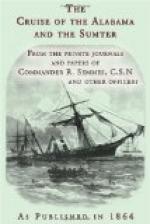At last, however, this time of suspense was over, and kind fortune came to their assistance in the shape of a threatening gale of so ugly an appearance that the captain determined not to run the risk of parting company, and thus altogether losing his awkward, but not the less valuable prize. Accordingly, having accepted from the master a ransom bond for eighty thousand dollars, he dismissed him to his ship, and amid the wildest demonstrations of delight from the closely-packed prisoners on board, the Tonawanda filled away, and was seen no more.
The wind now freshened to a tolerably fresh gale. Not sufficient, however, for the next two days to prevent the Alabama from chasing and capturing, on the 15th October, the United States barque Lamplighter, of Boston, from New York to Gibraltar, with a cargo of tobacco, which, however, as it proved, was never destined to soothe the ennui of the British soldier at that not very lively station. The sea was running high, and the boats had a rough time of it in boarding the barque, and returning with prisoners, &c. However, it was managed at last; the unlucky vessel was fired, and after burning fiercely for some time, went headforemost to the bottom, leaving behind her a savoury cloud that almost tempted her destroyers to regret their work.
And now it proved indeed fortunate for the prisoners who had so lately been discharged, that they were not doomed to weather out on the Alabama’s deck the gale that came upon her. The 17th of October saw the culminating of the bad weather that had prevailed during the last four or five days, and for some hours the Alabama was exposed to a perfect hurricane. The storm did not last long, but for about four hours it blew furiously. It was not yet at its height, and the ship was still carrying her close reefed maintopsail with reefed main trysail and fore topmast staysail, when a sharper lurch than usual threw a sudden strain upon the bumpkin to which the weather main brace was led, and in a moment it had snapped in two. The mainyard no longer supported by the brace, and pressed by the whole power of the straining topsail, flew forward and upward till it was bent nearly double, when with a loud crash it parted in the slings, splintering the topsail into ribands with a noise like thunder.
The ship was now in the greatest peril, for there was no longer sufficient after canvas to keep her head to the wind against the powerful pressure of the foretopmast staysail, and in another moment she must have fallen into the trough of the sea, and probably been at the least dismasted, if not altogether swamped. But the quick eye of the captain of the foretop saw the danger, and springing to the staysail halyards he cut the sail away, and the ship relieved of pressure forward, again came up to the wind.
The main trysail was now lowered, though not without splitting the sail, and a small three-cornered storm trysail hoisted in its place. Even under this minimum of canvas the tremendous pressure of the gale upon her spars forced her down in the water several streaks, and the idlers and boys were lashed for safety under the weather bulwarks, life-lines being stretched before them to prevent them from falling to leeward.




